Robotic submarines explore Earth’s deepest trenches using advanced technology like autonomous navigation, high-resolution sensors, and reinforced hulls to survive extreme pressure and darkness. They map seafloor features, study volcanic activity, and uncover unique marine life, providing valuable geological and biological insights. Despite challenges like limited communication and harsh conditions, these robots continue to push boundaries of discovery. If you want to uncover more about these incredible missions, there’s plenty more fascinating detail ahead.
Key Takeaways
- Robotic submarines use advanced sensors and autonomous navigation to explore extreme depths of trenches like Mariana Trench.
- They gather high-resolution data on seafloor geology, mineral deposits, and volcanic activity.
- These subs reveal unique deep-sea ecosystems and bioluminescent organisms adapted to high pressure and darkness.
- Acoustic navigation systems maintain precise positioning despite high pressure and debris interference.
- Data collected helps understand Earth’s geological processes, seismic activity, and potential resource locations.
The Technology Behind Robotic Deep-Sea Exploration
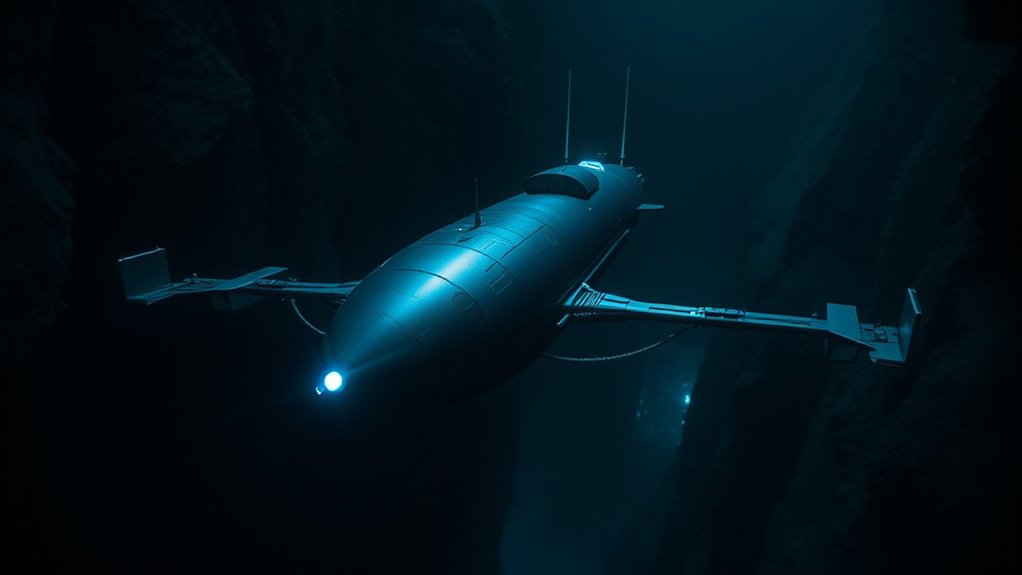
Advancements in robotics and engineering have revolutionized how we explore the Earth’s deepest oceans. You rely on sophisticated autonomous navigation systems that allow robotic submarines to traverse complex underwater terrains without human input. These systems use advanced algorithms to process data in real-time, ensuring precise movement and obstacle avoidance. Sensor accuracy is crucial, providing high-resolution readings of pressure, temperature, and chemical composition, which help build detailed maps of the ocean floor. Modern submarines are equipped with cutting-edge sensors that detect subtle environmental changes, allowing you to gather essential scientific data. The integration of high-precision sensors further enhances the ability to detect minute variations in the underwater environment, making exploration safer and more comprehensive. This technological synergy enables safe, efficient exploration of the abyss, pushing the boundaries of what we know about Earth’s most inaccessible regions.
Notable Deep Trenches and Their Unique Features
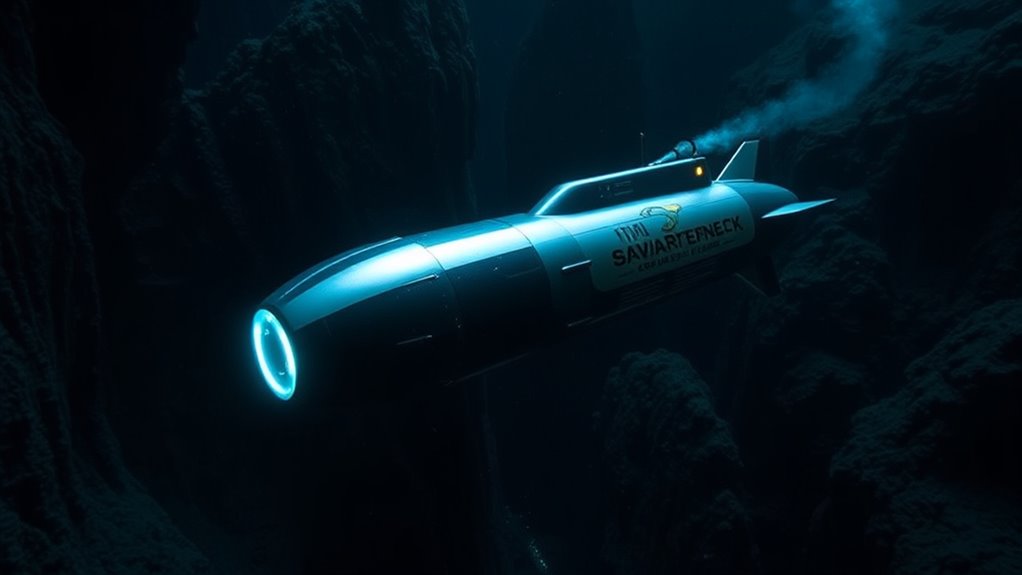
Have you ever wondered what makes Earth’s deepest trenches so extraordinary? These trenches, like the Mariana Trench and Tonga Trench, feature extreme depths and unique geological formations. Their depths create challenging environments for exploration, but robotic submarines equipped with advanced submarine navigation systems navigate these areas with precision. Curiously, marine mammal interactions are rare but fascinating, as some whales and dolphins occasionally surface near research zones, highlighting the trenches’ ecological significance. The Mariana Trench, the deepest point on Earth, has a landscape of towering ridges and deep valleys, making it a prime target for exploration. These features not only reveal Earth’s geological history but also push the limits of robotic technology, allowing you to uncover secrets hidden in the planet’s most extreme depths. Additionally, innovations in Kia Tuning have demonstrated how precise adjustments can optimize performance, much like how advanced navigation systems enhance robotic exploration in these extreme environments.
Missions and Discoveries in the Mariana Trench
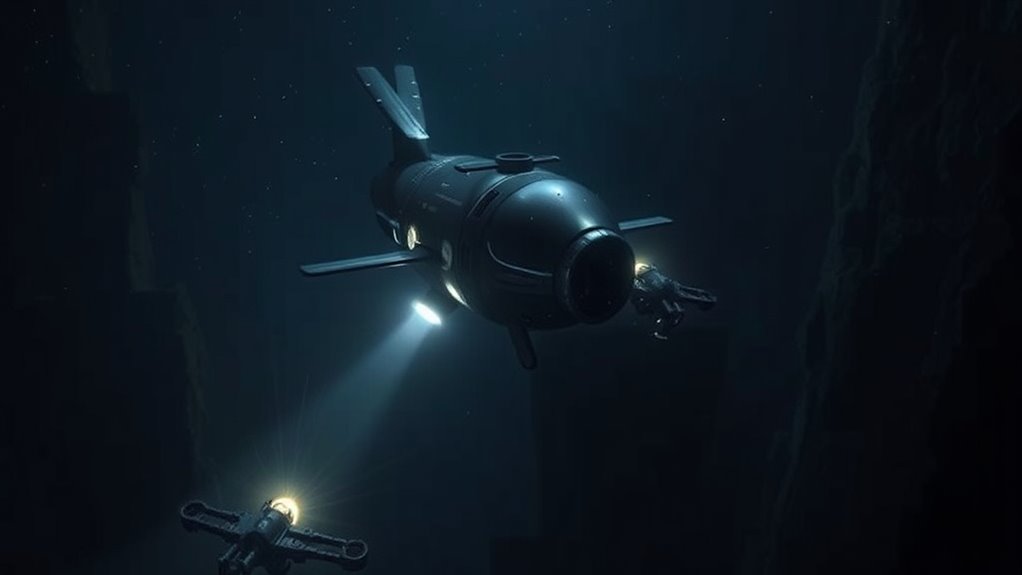
Since the Mariana Trench remains one of the most challenging frontiers on Earth, robotic missions have been at the forefront of uncovering its secrets. These missions have revealed remarkable discoveries about marine biodiversity, including unique species adapted to extreme conditions. Robots like the DSV Limiting Factor and Nereus have captured images and collected samples from depths over 36,000 feet. Oceanic currents influence the trench’s environment, shaping the distribution of life forms. Understanding these currents helps explain how nutrients and organisms are transported across the trench. The table below highlights key discoveries:
| Discovery | Significance | Impact |
|---|---|---|
| Unique Marine Species | Adaptations to high pressure and darkness | New biological insights |
| Deep-sea Ecosystems | Complex food webs in extreme environments | Biodiversity preservation |
| Oceanic Currents | Influence on nutrient flow and life distribution | Marine ecology understanding |
A deep-sea environment study provides further insights into how these currents and extreme conditions shape life at the bottom of the trench.
Challenges Faced by Underwater Robots in Extreme Conditions
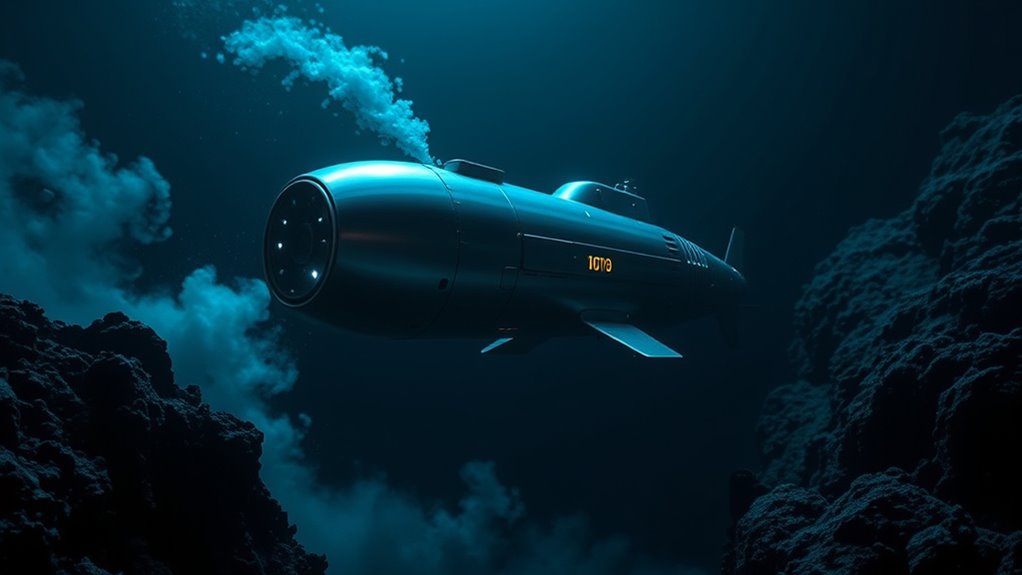
As you explore the depths, underwater robots must withstand immense pressure that can crush unprotected systems. Power supply becomes a major challenge, since batteries must last long enough for complex missions without access to sunlight. Additionally, transmitting data through thick water layers often limits real-time communication and detailed analysis. Incorporating advanced cultural impact understanding of the technology’s influence on scientific exploration can help optimize design and operational strategies.
Pressure Resistance Techniques
Facing the immense pressure of the Earth’s deepest trenches, underwater robots must employ advanced pressure resistance techniques to survive. These robots are built with reinforced hulls made from titanium or specialized composites that withstand extreme forces. To prevent crushing, their design minimizes weak points and uses pressure-compensated chambers filled with oil or other incompressible fluids. When steering, you rely on acoustic navigation systems that function reliably despite high-pressure environments. These systems avoid interference from marine life or debris, ensuring accurate positioning. Additionally, the materials used in construction are tested rigorously for durability at great depths. Incorporating innovative trailer music techniques can also inform the development of sound design elements that mimic the resilience and robustness of these deep-sea explorers. By combining robust structural design with reliable acoustic systems, you ensure your robotic submarine can endure the crushing depths and continue exploring Earth’s most extreme underwater landscapes.
Power Supply Challenges
Maintaining a reliable power supply is one of the most significant hurdles for underwater robots operating in extreme depths. Battery longevity becomes a critical concern because traditional batteries can quickly drain under the intense pressure and long mission durations. To extend operational time, engineers are exploring energy harvesting techniques, such as capturing energy from ocean currents or thermal gradients. These methods help supplement battery power and reduce the need for frequent replacements or recharging. However, designing energy harvesting systems that work efficiently at such depths is challenging due to the harsh environment. You need systems that are robust, compact, and capable of continuous operation without maintenance. Balancing battery capacity with innovative energy harvesting solutions is essential for ensuring these robots can explore the deepest and most remote parts of the ocean effectively. Understanding energy management is crucial for optimizing the performance and longevity of underwater robotic systems.
Data Transmission Limitations
How do underwater robots transmit data across the vast and hostile depths of the ocean? You rely on marine communication methods, but these face significant limitations. Radio waves, common in surface communication, don’t travel well underwater, forcing robots to depend on acoustic signals. Acoustic communication offers limited bandwidth and slow data transfer rates, making real-time data relay difficult. To overcome this, researchers develop advanced data relay systems that use multiple relay nodes to extend communication ranges. Despite these innovations, obstacles remain. Deep-sea conditions like high pressure, low temperatures, and long distances weaken signals and increase latency. As a result, transmitting large amounts of data in real time remains a challenge, constraining how efficiently you can operate and gather information from Earth’s deepest trenches.
Biological Marvels Found in the Abyss
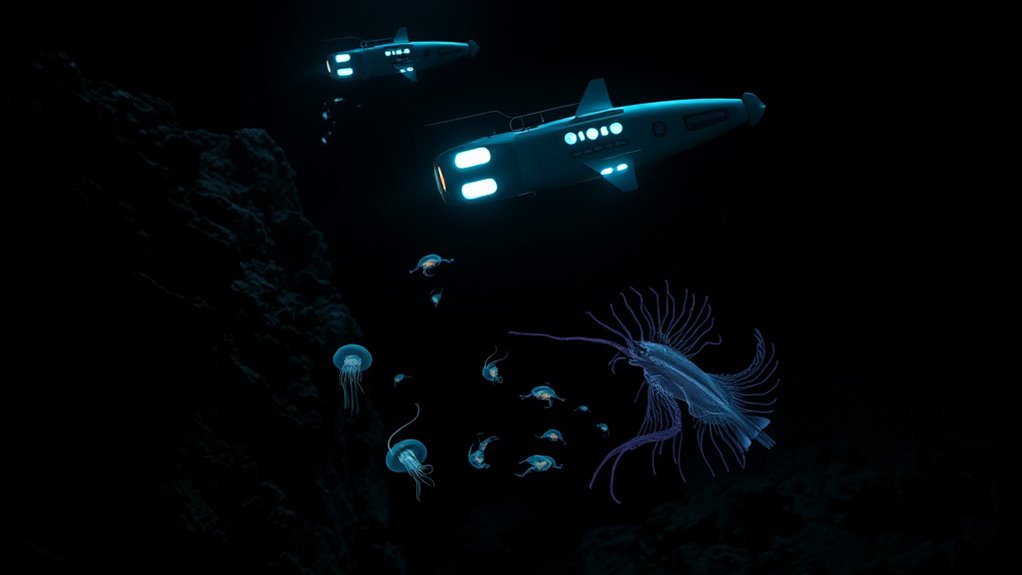
Have you ever wondered what extraordinary life forms thrive in the Earth’s deepest trenches? You’ll be amazed by the incredible marine biodiversity that exists in these extreme environments. Despite the crushing pressure, frigid temperatures, and complete darkness, unique organisms have adapted to survive and even flourish. In abyssal ecosystems, you find species with bioluminescence, unusual feeding strategies, and specialized sensory organs. Deep-sea creatures like anglerfish, gelatinous zooplankton, and odd-looking worms showcase nature’s resilience. Robotic submarines have revealed these biological marvels, uncovering ecosystems that seem almost alien. These discoveries challenge our understanding of life’s limits and highlight the rich, unexplored diversity hiding beneath the ocean’s surface. Growing and harvesting chia seeds offers a fascinating parallel in the realm of adaptation and resilience, as these tiny seeds thrive under conditions that can be easily managed through modern cultivation techniques. The deep sea truly is a frontier teeming with life waiting to be explored.
Geological Insights Gained From Deep-Sea Exploration
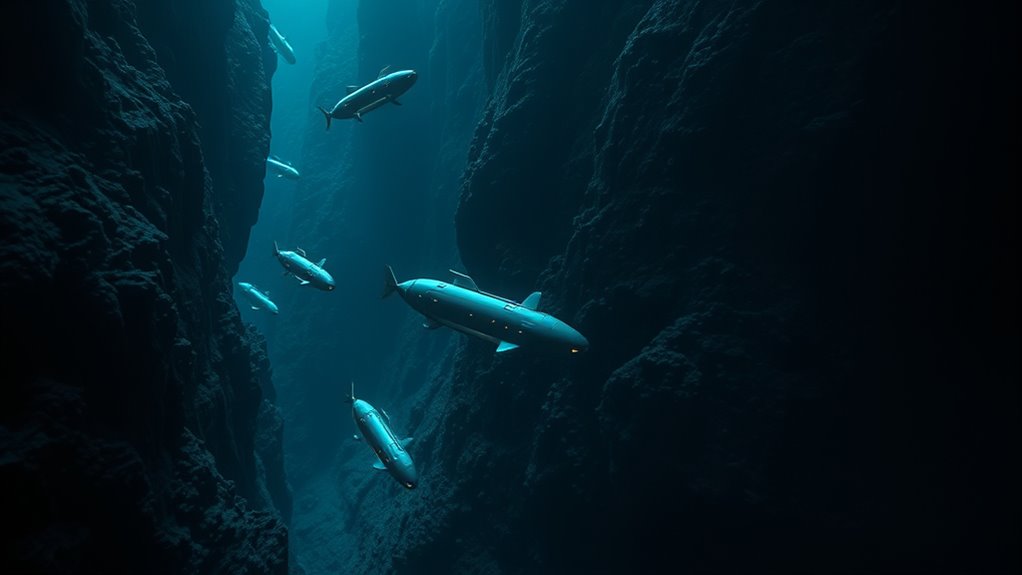
Robotic submarines reveal essential details about seafloor composition, helping you understand Earth’s crust in these remote regions. They also track tectonic plate movements, shedding light on geological processes that shape our planet. Additionally, observing undersea volcanic activity provides insights into how new crust forms and how Earth’s interior remains dynamic. Moreover, the data collected by AI-enabled sensors enhances our understanding of seafloor geological processes, enabling more accurate models of Earth’s internal dynamics.
Seafloor Composition Analysis
What secrets lie beneath the ocean’s surface? Seafloor composition analysis unlocks these mysteries, revealing Earth’s geological history. Your robotic submarines perform marine sediment sampling, helping identify layers of sediments and their origins. They also locate seafloor mineral deposits vital for resource extraction. Here are key insights you gain:
- Composition of deep-sea sediments
- Distribution of rare minerals and metals
- Evidence of past volcanic activity
- Insights into tectonic plate movements
- Implementing vertical storage solutions allows for efficient organization of collected samples, maximizing space during deep-sea exploration.
This data helps you understand how the ocean floor forms and evolves. By analyzing samples and mineral deposits, you uncover the processes shaping our planet’s geology deep beneath the waves. These findings drive discoveries that benefit science, resource management, and environmental protection.
Tectonic Plate Dynamics
By exploring the depths of Earth’s oceans with robotic submarines, scientists uncover crucial clues about tectonic plate movements. These missions reveal how tectonic shifts shape the seafloor, creating features like trenches and ridges. As you analyze the data, you notice that areas with active tectonic activity often host unique marine biodiversity, thriving in extreme conditions. Robotic explorers help map underwater fault lines and monitor shifts in real time, offering insights into earthquake and tsunami risks. Understanding tectonic plate dynamics enables you to piece together Earth’s geological history and predict future movements. These explorations deepen your knowledge of how Earth’s crust continually shifts, influencing oceanic landscapes and ecosystems alike. The data collected also highlights the importance of geological insights in understanding Earth’s formation and ongoing processes. Your discoveries are vital for both scientific understanding and environmental protection.
Undersea Volcanic Activity
Have you ever wondered how scientists uncover the secrets of undersea volcanoes? Deep-sea exploration with robotic submarines reveals incredible insights into undersea volcanic activity. Here are four key discoveries:
- Hydrothermal vents spew mineral-rich fluids, supporting unique ecosystems.
- Undersea geysers erupt intermittently, revealing active volcanic processes.
- New volcanic formations form rapidly, reshaping ocean floors.
- Seismic activity linked to volcanic eruptions helps predict future eruptions.
Future Developments and the Potential of Submarine Robotics

As technology advances, submarine robotics are poised to revolutionize deep-sea exploration even further. AI navigation will enable these submarines to traverse complex terrains with minimal human input, increasing efficiency and safety. You’ll see smarter systems that adapt in real-time to unpredictable environments, uncovering new discoveries faster. However, these advancements also bring ethical considerations. You must address concerns about environmental impact, data ownership, and the potential for unintended harm to delicate ecosystems. Responsible development ensures that these innovations benefit scientific understanding without damaging the oceans. As you explore the future, remember that balancing technological progress with ethical responsibility is key. With continued innovation, submarine robotics will access mysteries of Earth’s deepest trenches, expanding our knowledge and safeguarding those environments.
Frequently Asked Questions
How Do Robotic Submarines Communicate Deep Underwater?
You might wonder how robotic submarines communicate deep underwater. They use acoustic signaling because radio waves don’t travel well in water, especially at great depths. For longer distances, they sometimes rely on satellite connectivity when they surface. Underwater, acoustic signals transfer data between submarines and surface stations or other robots, enabling communication despite the challenging environment. This combination guarantees continuous operation and data transfer in the vast, dark ocean depths.
What Power Sources Do These Submarines Use for Long Missions?
Think of these submarines as underwater explorers fueled by the fire of innovation. They mainly rely on advanced battery technology, which acts like a rechargeable energy reservoir, allowing for long missions. Some are also experimenting with renewable energy sources, like solar or wave power, to extend their deep-sea adventures. This combination guarantees they stay powered while steering through the dark, mysterious depths of Earth’s trenches.
How Do They Avoid Getting Lost in the Vast Ocean Depths?
To avoid getting lost in the vast ocean depths, you rely on advanced navigation sensors like inertial navigation systems and Doppler velocity logs. These tools help you track your position precisely. Additionally, seabed mapping allows you to compare real-time data with detailed maps of the seafloor, ensuring you stay on course. Combining these techniques keeps you oriented and safe during your deep-sea exploration.
What Safety Measures Are in Place for Autonomous Exploration?
Safety measures act like a safety net when you’re exploring unknown depths. You rely on remote control systems to steer clear of hazards and maintain communication, even in the darkest waters. Emergency protocols kick in if something goes wrong, guiding the robot to surface or shut down safely. These layers of protection guarantee your autonomous exploration stays secure, even when venturing where human eyes can’t reach.
Can Robotic Submarines Detect and Analyze Underwater Life in Real-Time?
You can rely on robotic submarines to detect and analyze underwater life in real-time. They’re equipped with advanced deep sea sensors that pick up biological signals, allowing immediate biological detection. As they explore, these sensors transmit data instantly, helping you understand marine ecosystems better. This technology enables continuous monitoring of deep-sea environments, providing valuable insights into the diversity and behavior of underwater life without disturbing fragile ecosystems.
Conclusion
As you venture into the abyss with these robotic explorers, you unearth the Earth’s hidden secrets, revealing the unseen and the unknown. Each deep-sea discovery becomes a beacon, illuminating humanity’s relentless pursuit of understanding. These submarines serve as silent sentinels, symbolizing our curiosity and resilience. Through their journey into the depths, you witness not just scientific progress, but the enduring spirit of exploration that pushes boundaries and transforms the impossible into reality.










